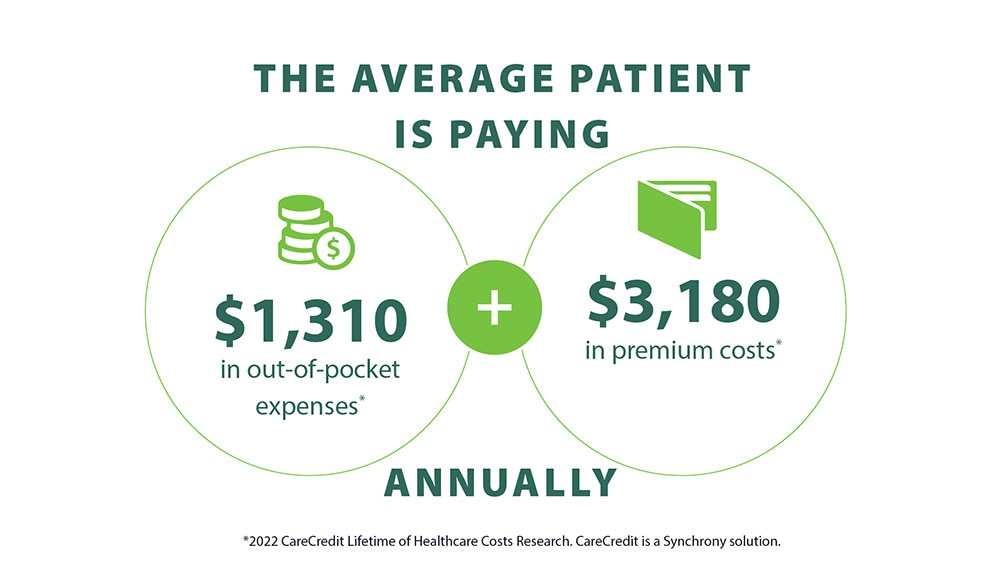How to Talk About Financing Options with Patients
Discover helpful ways to effectively communicate financial responsibilities and financing options with patients before, during and after care.
By Synchrony, Health & Wellness
Posted Sep 13, 2024 - 6 min read

Healthcare providers are continually balancing more than just patient care—administrative issues, billing concerns and staffing take up a lot of mental load in providers' days. But worrying about revenue cycle concerns doesn't need to be another burden. Discussing financing with patients can help manage collections and increase time to receive payments.
In this article, you'll learn why it's important for health systems and healthcare professionals to prioritize transparency, sensitivity and education about financial obligations in patient communication, and discover strategies to improve.
Patients Face Higher Healthcare Costs
Patients continue to face rising healthcare costs that may make getting the care they want and need difficult. The average patient is paying $1,310 in out-of-pocket expenses and $3,180 annually in premium costs, according to a 2022 Synchrony Lifetime of Healthcare Costs report.1
Additionally, according to the 2021 Healthcare Consumer Experience Study from Cedar, some of the key improvements patients are hoping to see around the payment experience after a hospital visit or treatment include:2
- Better explanations of bills
- Improved communication between provider and payer
- Accurate accounting of out-of-pocket costs
- Consumer-friendly payment methods
Your system can set the standard by improving communication with patients about their financial responsibilities and helping them understand the billing process. Knowing how much or how to pay can help the patient feel more in control. It can also help improve patient retention.
Preparing to Talk About Patient Financing Options
Before you have the conversation about your patient's financial obligations, prepare yourself with some key research to ensure you can answer inevitable patient questions and direct the patient to the best resources to help them pay seamlessly.
Presenting patient financing options: Don't expect patients to know what their financing options are—they may need to be guided toward options available to them. Having financing options available will allow healthcare providers to help patients choose the best care possible. Additionally, transparency around payment options has been shown to improve the patient experience.3
Guiding patients through health insurance coverage and government programs: While healthcare providers may not know all the particulars of their patients' health insurance coverage, they can clearly communicate with patients about how to acquire an explanation of benefits , how to apply for financing or government programs if needed, and what approximate copays and other out-of-pocket costs may be their responsibility.
Discussing Patient Financing Options
A health system can help relieve patients' stress by communicating financial responsibilities as early as possible. Your employees can explain that there may be ways to pay for care that help them manage their budget. When you can, offer convenient monthly payments and various payment options to meet their preferences and help set their minds at ease.
Flexible payment options may improve the patient experience, particularly when patients have a variety of payment options. On the flip side, a lack of flexibility in payment options can put patients in the position of not making payments and ending up with bills in collections.4
Consider offering:
The ability for patients to manage the costs of their healthcare over time, whether through in-office payment plans, financing options such as the CareCredit credit card, or government programs that reduce the cost of healthcare.
Flexible payment options. The more forms of payment a healthcare system can offer, the more likely patients are going to be able to pay—and on time. These payment methods can include:
- Debit/credit card
- Website or online payment portal
- Check
- Mobile payment app with QR codes
- Self-service interactive voice response automated phone technology
- Automated payment plan, or a way to manage the costs of care with convenient monthly payments
Presenting flexible payment options may improve the patient experience and reduce stress. That way, patients can focus more on wellness and less on finances.5
Use each interaction to tactfully offer the opportunity to pay a portion or the entire bill. Include prompts for bill payment while scheduling appointments; in automated email messages, text or voice reminders; or through other patient engagement strategies. Invest the time now to help reduce future time spent on phone calls with patients, payment delays or missed appointments.
Exploring Financial Counseling for Patients
If a patient is struggling to pay for healthcare services, it may be necessary to direct them to a patient financial counselor.
These counselors can play a key role in helping patients know their financial responsibilities and how to pay for them. They can help patients to:6
- Communicate with their insurance companies on the phone.
- Document and report payment information.
- Learn about payment options and financial assistance.
- Negotiate and organize patient payment arrangements.
- Review and process insurance forms.
Communicating Financial Responsibilities
It can be challenging to determine how or when to discuss the costs of care with patients. Many patients may resist these conversations out of feelings of shame, fear or other problems such as dealing with a chronic illness, financial hardships or worries about a health diagnosis.4 Reviewing payment options may feel uncomfortable, but it doesn't have to be complicated. In fact, when done well, this conversation can help patients feel empowered.
Help employees to act as a resource and improve the patient experience by providing regular training on patient engagement strategies about financial responsibilities. You can use scripts to detail how, when and what to say to assist employees with patient engagement. These conversations may provide opportunities to recognize signs that a patient may benefit from financing options or a payment plan.

How to Communicate: A Guide
- Use simple language and try to avoid the use of medical jargon, acronyms and confusing terms.
- Be as transparent as possible—state in advance what the cost covers, and encourage questions.
- Repeat or rephrase your answers to the patient's questions and the information you provide to help ensure the patient understands.
- Explain payment options and ways to manage the cost of care, such as financing with convenient monthly payments available with the CareCredit credit card.
- Research payment information if you don't have an immediate answer for the patient, and be sure to get back to them in a timely manner.
What to Communicate
- Do your best to provide cost estimates so the patient understands and can prepare for financial obligations.
- Offer multiple, flexible payment options, such as financing with convenient monthly payments available with the CareCredit credit card.
- Explain what insurance is likely to cover .
- Discuss and agree upon the best approach to meet financial responsibilities.
When to Communicate
- Before care: When possible, provide price transparency on your website or other informational materials by listing the costs of standard services, sharing articles that clarify insurance terms or including a cost estimation calculator.
- While scheduling care: Remind patients to bring insurance cards, gently explain whether a copayment is required and ask about patients' preferred payment method.
- During care: Display information and offer the patient a hard copy to help ensure they understand their financial responsibility before leaving the office.
- After care: Communicate with patients about their financial responsibility through various methods, such as text, phone call, email and web portal reminders, as well as follow-up appointments.
Communicating Early and Often
During a busy office day, it may be tempting to gather only the charges required at the visit and not worry about additional costs. But when health systems provide transparency regarding fees, it can help set expectations early and allow time to respond to patients' questions.
In all communications, be aware of issues that may affect patient understanding, such as:7
- Literacy
- Vision or hearing challenges
- Caregivers assisting with payments
- Need for a medical interpreter
Consider methods that can improve patient satisfaction by asking about their communication preferences and being responsive to their needs. Ask staff to clarify whether the patient:
- Prefers a phone call or would like to receive a physical copy of their information in the mail.
- Only answers phone calls from numbers they recognize or delays checking their voicemail for days.
- Can't answer calls during their workday, or doesn't have time to wait on hold.
- Wants to receive information via text messages.
Note patient communication preference and offer multiple options, such as:
- Phone calls
- Physical copies sent through the mail
- Text messages
- Emails
- Online portal messages
Texting has become a more popular method of patient communication because it is more efficient than calling for both patients and employees, and patients often read the messages sooner.8 However, health systems need to be mindful of the Telephone Consumer Protection Act and any state regulations that may require consent from a patient before sending certain communications by text.9
Following Up With Patients
Communicating once with a patient about their financing options may not be enough. It's a good idea to follow up with patients through their preferred communication methods to ensure they understand their financing options and to see if they need additional assistance. Healthcare providers should keep clear records of the financing options discussed.10
Healthcare payment and financing solution
The CareCredit health and wellness credit card helps improve the payment experience for patients and clients, and your financial performance.
Get StartedReady to help more patients and clients get the care they want and need?
Get StartedReady to help more patients and clients get the care they want and need?
Get StartedThis content is subject to change without notice and offered for informational use only. You are urged to consult with your individual business, financial, legal, tax and/or other advisors with respect to any information presented. Synchrony and any of its affiliates, including CareCredit, (collectively, “Synchrony”) makes no representations or warranties regarding this content and accept no liability for any loss or harm arising from the use of the information provided. Your receipt of this material constitutes your acceptance of these terms and conditions.
Sources:
1 Lifetime of Healthcare Costs Research. Synchrony. Published November 2022. https://image.emails.carecredit.com/lib/fe331570756406747d1173/m/2/1a90c56b-55cd-4ba9-ab0f-97907af17049.pdf
2 2021 Healthcare Consumer Experience Study. Cedar. https://www.cedar.com/2021-consumer-healthcare-study/
3 Kaplan, D.A. Discussing Costs of Care with Patients. Medical Economics. Published June 5, 2020. https://www.medicaleconomics.com/view/discussing-costs-care-patients
4 Blitch, B. 10 Ways to Enhance the Patient Payment Experience. Healthcare Financial Management Association. Published February 7, 2019. https://www.hfma.org/63225/
5 Brogan, N. How to Communicate Clearly with Patients About Healthcare Costs. Medical Economics. Published August 7, 2019. https://www.medicaleconomics.com/view/how-to-communicate-clearly-with-patients-about-healthcare-costs
6 Patient Financial Counselor. HealthCare Support. Published February 26, 2014. https://www.healthcaresupport.com/patient-financial-counselor/
7 ADA Requirements: Effective Communication. ADA. gov. Published January 1, 2014. Updated February 28, 2020. https://www.ada.gov/resources/effective-communication/
8 Weiner, J. COVID-19 and the Rise of Texting in Health Care. Oncology Nursing News. Published June 16, 2021. https://www.oncnursingnews.com/view/covid-19-and-the-rise-of-texting-in-health-care
9 FCC Actions on Robocalls, Telemarketing. Federal Communications Commission. Published July 23, 2018. https://www.fcc.gov/general/telemarketing-and-robocalls#:~:text=In%20an%20effort%20to%20address,artificial%20or%20prerecorded%20voice%20messages.
10 Health Literacy Universal Precautions Toolkit, 2nd Edition. Agency for Healthcare Research and Quality. Published February 2015. Reviewed September 2020. https://www.ahrq.gov/health-literacy/improve/precautions/tool6.html




